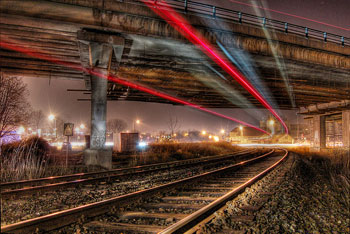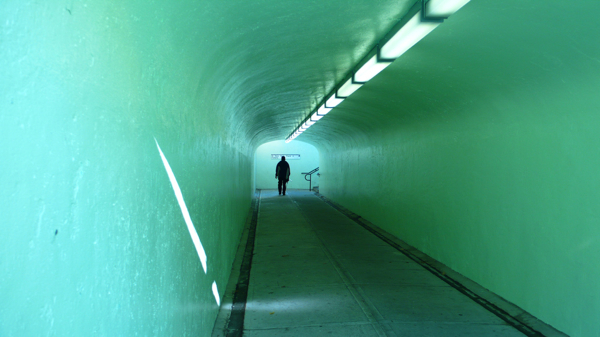
Photo by stevacek
When framing a landscape shot one of the types of environmental features that many photographers look for and like to incorporate in their shots is converging lines.
We’ve talked previously about how lines have the potential to add interest to an image – but multiple lines that converge together (or come close to one another) can be a great technique to lead your viewers eye into a shot.
Perhaps the classic example (and one that’s probably been overdone) of converging lines are railway tracks.
Position yourself in the middle of two tracks (after taking a look at what might be coming from behind) and you’ll see the two tracks on either side of you appear to get closer and closer together as they go into the distance.
Take this shot and the natural reaction for those looking at the scene will be for them to follow the lines off into the distance. In a sense the two lines act like a funnel which directs the gaze of those entering them in a certain direction.
The same effect can be achieved with roads or pathways, converging fence lines, a set of stairs, power lines or virtually any other lines that run parallel into the distance or that actually converge at some point.
4 Tips Regarding Converging Lines
1. Experiment with Positioning – the classic railway line shot described above has many possibilities. One is to position the tracks dead center and symmetrically in the shot.
Another positioning would be to step to one side of the tracks and let them run diagonally through your frame from a lower corner to the opposite upper corner. The beauty of this is that you’ll end up with a more dynamic shot. Symmetrical and vertical placement of the lines can be powerful but diagonal lines tend to convey movement.
Alternatively stepping away from the start of the lines can give another perspective – as can holding your camera on an angle to give another diagonal framing of the lines.
2. Wide Angle Lenses – different lenses can totally change the impact of a shot with converging lines. I find that a wide angle lens can be particularly useful – especially when positioning yourself between the two lines.
This will help to give the perception that the distance between the lines at the starting point of the image is wider than it is. This exaggeration of the width of your lines can have a powerful impact upon your shot.

Photo by MarvinOS
3. Positioning the ‘convergence’ – one thing to consider when you have converging lines in an image is that they draw the eye into a shot – towards the point that they converge – this becomes one of the most important parts of this image – a focal point.
As you’re framing your shot ask yourself – ‘where is the most effective position to frame this?”
Keep in mind rules like the Rule of Thirds that says that the intersecting points of imaginary lines a third of the way into an image are key points for positioning points of interest.
Also know that if the point of convergence is outside the frame of the shot that you are leading the eye out of your shot. This could leave a shot unbalanced and with tension – alternatively it could enhance the shot and leave your viewers wondering about the place that they converge.
4. Adding Interest at the Point of Convergence – Sometimes it is worth enhancing the point of convergence with something of interest (for example waiting until a train appears in the distance on the tracks – or positioning a person at the top of stairs) – on other occasions the composition of the shot is strong enough without adding an extra subject.
If you’ve got some examples of converging lines in images that you’ve taken I’d love to see them over at the DPS forums – either in the How I took It or Critique My Shot sections.
Here are a few more Converging Lines shots to illustrate the point and hopefully give a little inspiration.
 Image by MarkyBon
Image by MarkyBon
 Image by Loving Earth
Image by Loving Earth
 Image by vividiti
Image by vividiti
 Image by Lush.i.ous
Image by Lush.i.ous
 Image by Aeloux
Image by Aeloux
Post originally from: Digital Photography Tips.
Check out our more Photography Tips at Photography Tips for Beginners, Portrait Photography Tips and Wedding Photography Tips.
How to Use Converging Lines to Enhance Your Photography

Digital Photography School

 Photo by stevacek
Photo by stevacek Photo by MarvinOS
Photo by MarvinOS Image by MarkyBon
Image by MarkyBon Image by Loving Earth
Image by Loving Earth Image by vividiti
Image by vividiti Image by Lush.i.ous
Image by Lush.i.ous Image by Aeloux
Image by Aeloux